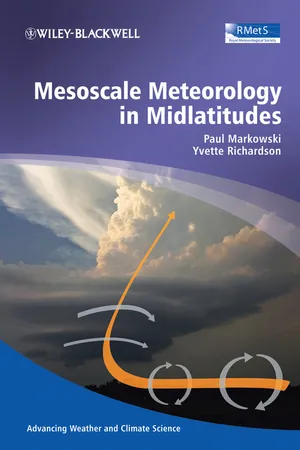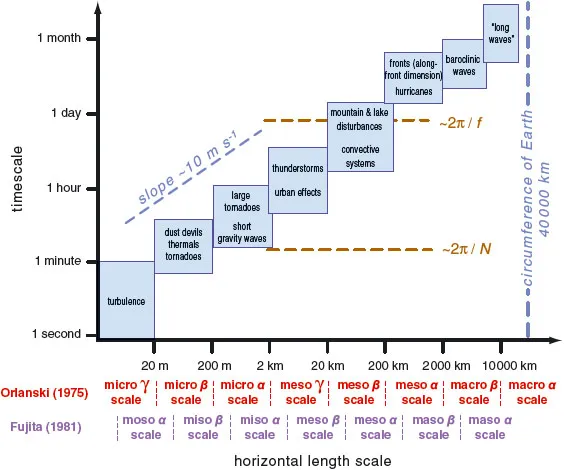
- English
- ePUB (mobile friendly)
- Available on iOS & Android
eBook - ePub
Mesoscale Meteorology in Midlatitudes
About this book
Mesoscale Meteorology in Mid-Latitudes presents the dynamics of mesoscale meteorological phenomena in a highly accessible, student-friendly manner. The book's clear mathematical treatments are complemented by high-quality photographs and illustrations. Comprehensive coverage of subjects including boundary layer mesoscale phenomena, orographic phenomena and deep convection is brought together with the latest developments in the field to provide an invaluable resource for mesoscale meteorology students.
Mesoscale Meteorology in Mid-Latitudes functions as a comprehensive, easy-to-use undergraduate textbook while also providing a useful reference for graduate students, research scientists and weather industry professionals.
- Illustrated in full colour throughout
- Covers the latest developments and research in the field
- Comprehensive coverage of deep convection and its initiation
- Uses real life examples of phenomena taken from broad geographical areas to demonstrate the practical aspects of the science
Frequently asked questions
Yes, you can cancel anytime from the Subscription tab in your account settings on the Perlego website. Your subscription will stay active until the end of your current billing period. Learn how to cancel your subscription.
No, books cannot be downloaded as external files, such as PDFs, for use outside of Perlego. However, you can download books within the Perlego app for offline reading on mobile or tablet. Learn more here.
Perlego offers two plans: Essential and Complete
- Essential is ideal for learners and professionals who enjoy exploring a wide range of subjects. Access the Essential Library with 800,000+ trusted titles and best-sellers across business, personal growth, and the humanities. Includes unlimited reading time and Standard Read Aloud voice.
- Complete: Perfect for advanced learners and researchers needing full, unrestricted access. Unlock 1.4M+ books across hundreds of subjects, including academic and specialized titles. The Complete Plan also includes advanced features like Premium Read Aloud and Research Assistant.
We are an online textbook subscription service, where you can get access to an entire online library for less than the price of a single book per month. With over 1 million books across 1000+ topics, we’ve got you covered! Learn more here.
Look out for the read-aloud symbol on your next book to see if you can listen to it. The read-aloud tool reads text aloud for you, highlighting the text as it is being read. You can pause it, speed it up and slow it down. Learn more here.
Yes! You can use the Perlego app on both iOS or Android devices to read anytime, anywhere — even offline. Perfect for commutes or when you’re on the go.
Please note we cannot support devices running on iOS 13 and Android 7 or earlier. Learn more about using the app.
Please note we cannot support devices running on iOS 13 and Android 7 or earlier. Learn more about using the app.
Yes, you can access Mesoscale Meteorology in Midlatitudes by Paul Markowski,Yvette Richardson in PDF and/or ePUB format, as well as other popular books in Physical Sciences & Meteorology & Climatology. We have over one million books available in our catalogue for you to explore.
Information
PART I: General Principles
1
What is the Mesoscale?
1.1 Space and time scales
Atmospheric motions occur over a broad continuum of space and time scales. The mean free path of molecules (approximately 0.1 μm) and circumference of the earth (approximately 40 000 km) place lower and upper bounds on the space scales of motions. The timescales of atmospheric motions range from under a second, in the case of small-scale turbulent motions, to as long as weeks in the case of planetary-scale Rossby waves. Meteorological phenomena having short temporal scales tend to have small spatial scales, and vice versa; the ratio of horizontal space to time scales is of roughly the same order ofmagnitude for most phenomena (~10m s−1) (Figure 1.1).
Before defining the mesoscale it may be easiest first to define the synoptic scale. Outside of the field of meteorology, the adjective synoptic (derived from the Greek synoptikos) refers to a “summary or general view of a whole.” The adjective has a more restrictive meaning to meteorologists, however, in that it refers to large space scales. The first routinely available weathermaps, produced in the late 19th century, were derived from observations made in Europeancities having a relatively coarse characteristic spacing. These early meteorological analyses, referred to as synoptic maps, paved the way for the Norwegian cyclone model, which was developed during and shortly afterWorld War I. Because only extratropical cyclones and fronts could be resolved on the early synoptic maps, synoptic ultimately became a term that referred to large-scale atmospheric disturbances.
The debut of weather radars in the 1940s enabled phenomena to be observed that were much smaller in scale than the scales of motion represented on synoptic weather maps. The term mesoscale appears to have been introduced by Ligda (1951) in an article reviewing the use of weather radar, in order to describe phenomena smaller than the synoptic scale but larger than the microscale, a term that was widely used at the time (and still is) in reference to phenomena having a scale of a few kilometers or less.1 The upper limit of the mesoscale can therefore be regarded as being roughly the limit of resolvability of a disturbance by an observing network approximately as dense as that present when the first synoptic charts became available, that is, of the order of 1000 km.
At least a dozen different length scale limits for the mesoscale have been broached since Ligda’s article. The most popular bounds are those proposed by Orlanski (1975) and Fujita (1981).2 Orlanski defined the mesoscale as ranging from 2 to 2000 km, with subclassifications of meso-α, meso-β, andmeso-γ scales referring to horizontal scales of 200–2000 km, 20–200 km, and 2–20 km, respectively (Figure 1.1). Orlanski defined phenomena having scales smaller than 2 km as microscale phenomena, and those having scales larger than 2000 km as macroscale phenomena. Fujita (1981) proposed a much narrower range of length scales in his definition of mesoscale, where the mesoscale ranged from 4 to 400 km, with subclassifications of meso-α and meso-β scales referring to horizontal scales of 40–400km and 4–40 km, respectively (Figure 1.1).
Figure 1.1 Scale definitions and the characteristic time and horizontal length scales of a variety of atmospheric phenomena. Orlanski’s (1975) and Fujita’s (1981) classification schemes are also indicated.

Fujita’s overall scheme proposed classifications spanning two orders ofmagnitude each; in addition to themesoscale, Fujita proposed a 4 mm–40 cm musoscale, a 40 cm–40m mososcale, a 40m–4 km misoscale, and a 400–40 000 km masoscale (the vowels A, E, I, O, and U appear in alphabetical order in each scale name, ranging from large scales to small scales). As was the case for Fujita’s mesoscale, each of the other scales in his classification scheme was subdivided into α and β scales spanning one order of magnitude.
The specification of the upper and lower limits of the mesoscale does have some dynamical basis, although perhaps only coincidentally. The mesoscale can be viewed as an intermediate range of scales on which few, if any, simplifications to the governing equations can be made, at least not simplifications that can be applied to all mesoscale phenomena.3 For example, on the synoptic scale, several terms in the governing equations can safely be disregarded owing to their relative unimportance on that scale, such as vertical accelerations and advection by the ageostrophic wind. Likewise, on the microscale, different terms in the governing equations can often be neglected, such as the Coriolis force and even the horizontal pressure gradient force on occasion.On the mesoscale, however, the full complexity of the unsimplified governing equations comes into play. For example, a long-livedmesoscale convective system typically contains large pressure gradients and horizontal and vertical accelerations of air, and regions of substantial latent heating and cooling and associated positive and negative buoyancy, with the latent heating and cooling profiles being sensitive tomicrophysical processes. Yet even the Coriolis force and radiative transfer effects have been shown to influence the structure and evolution of these systems.
The mesoscale also can be viewed as the scale on which motions are driven by a variety of mechanisms rather than by a single dominant instability, as is the case on the synoptic scale in midlatitudes.4 Mesos...
Table of contents
- Cover
- Copyright
- Dedication
- Series Foreword
- Preface
- Acknowledgments
- List of Symbols
- PART I: General Principles
- PART II: Lower Tropospheric Mesoscale Phenomena
- PART III: Deep Moist Convection
- PART IV: Orographic Mesoscale Phenomena
- PART V: Appendix
- References
- Index